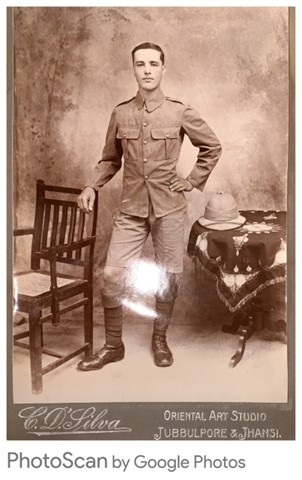Pte
Alfred James Bartlett
Information about birth
|
Year of birth: 1881 |
|
Place of birth: Deptford, Kent, England, United Kingdom |
General information
|
Last known residence: 97 Beckenham Lane, Shortlands, Bromley, Kent, England, United Kingdom |
|
Profession: landscapper |
Army information
|
Country: England, United Kingdom |
|
Force: British Expeditionary Force |
|
Rank: Private |
|
Service number: G/2030 |
|
Enlistment place: Deptford, Kent, England, United Kingdom |
|
Units: — The Queen’s Own (Royal West Kent Regiment), 1st Bn. (Last known unit) |
Information about death
|
Date of death: 26/10/1917 |
|
Place of death: Scheriabeek, Geluveld, Belgium |
|
Cause of death: Killed in action (K.I.A.) |
|
Age: 36 |
Memorial
|
Tyne Cot Memorial Panel: 107 A |
Distinctions and medals 3
|
1914-15 Star Medal |
|
British War Medal Medal |
|
Victory Medal Medal |
Points of interest 4
| #1 | Place of birth | ||
| #2 | Last known residence | ||
| #3 | Enlistment place | ||
| #4 | Place of death (approximate) |
My story
Alfred James Bartlett was the son of Charles and Priscilla Bartlett. He was born around 1881 in Deptford, Kent, UK. He married Elizabeth and together they had 5 children. Alfred worked as a coal miner. In 1915, Alfred enlisted in the British army. He belonged to the 1st Battalion Queen's Own Royal West Kent Regiment (13th Brigade, 5th Division). His brothers Harry and Walter also enlisted in the British Army.
Alfred died on 26 October 1917 during the Second Battle of Passchendaele, part of the Battle of Passchendaele. To make the barrage and capture of Geluveld more likely to succeed, the 1st Battalion Queen's Own Royal West Kent Regiment left the trenches where they were initially deployed and assembled some 280 metres behind the line taken on 4 October. However, German patrols noticed the empty trenches and took the abandoned lines, forcing the battalion to retake their own trenches under machine-gun fire. At 4.30am, the German troops opened a barrage, which caused some casualties and weakened the attacking troops. Nevertheless, the attack went ahead and the battalion managed to take the objective, which was on the outskirts of Geluveld. However, the attack by the 7th Division, which was on the battalion's left, failed. This left the battalion unprotected in the event of a counterattack. They withdrew and formed a defensive line, located slightly beyond the original starting line north of the Menin Road.
Alfred James Bartlett was one of the 347 casualties on 26 October. His body was not found or identified. His name is commemorated on the Tyne Cot Memorial (stone 107 A). His two brothers were also killed: Harry fell on 2 December 1917 around Tincourt and is buried in Tincourt Cemetery. Walter died on 18 September 1918 during the Second Battle of Cambrai and is buried in Ronssoy Cemetery.
Alfred died on 26 October 1917 during the Second Battle of Passchendaele, part of the Battle of Passchendaele. To make the barrage and capture of Geluveld more likely to succeed, the 1st Battalion Queen's Own Royal West Kent Regiment left the trenches where they were initially deployed and assembled some 280 metres behind the line taken on 4 October. However, German patrols noticed the empty trenches and took the abandoned lines, forcing the battalion to retake their own trenches under machine-gun fire. At 4.30am, the German troops opened a barrage, which caused some casualties and weakened the attacking troops. Nevertheless, the attack went ahead and the battalion managed to take the objective, which was on the outskirts of Geluveld. However, the attack by the 7th Division, which was on the battalion's left, failed. This left the battalion unprotected in the event of a counterattack. They withdrew and formed a defensive line, located slightly beyond the original starting line north of the Menin Road.
Alfred James Bartlett was one of the 347 casualties on 26 October. His body was not found or identified. His name is commemorated on the Tyne Cot Memorial (stone 107 A). His two brothers were also killed: Harry fell on 2 December 1917 around Tincourt and is buried in Tincourt Cemetery. Walter died on 18 September 1918 during the Second Battle of Cambrai and is buried in Ronssoy Cemetery.
Sources 9
|
1 Battalion Queen's Own (Royal West Kent Regiment) (The National Archvies, KEW (TNA), WO 95/1555/1). https://www.nationalarchives.gov.uk/ Sources used |
|
Atkinson, C.T. The Queen's Royal West Kent Regiment 1914-1919 (Uckfield: The Naval & Military Press Ltd), 300-303. Sources used |
|
British Army World War I Medal Rolls Index Cards, 1914-1920 (The National Archives, Kew (TNA), WO 372). https://www.nationalarchives.gov.uk/ Sources used |
|
Census Returns of England and Wales, 1891 (The National Archives, Kew (TNA) RG12). https://www.nationalarchives.gov.uk/ Sources used |
|
Census Returns of England and Wales, 1901 (The National Archives, Kew (TNA) RG13). https://www.nationalarchives.gov.uk Sources used |
|
Census Returns of England and Wales, 1911 (The National Archives, Kew (TNA) RG14). https://www.nationalarchives.gov.uk/ Sources used |
|
McCarthy, Chris. Passchendaele: The Day by Day Account (Londen: Arms & Armour Press, 1995), 144-145. Sources used |
|
Molony, C.V. Invicta: With the 1st Battalion The Queen's Own Royal West Kent Regiment in The Great War (London: Nisbet & Co.Ltd., 1923), 187-191. Sources used |
|
Soldiers Effects Records (National Army Museum, Chelsea (NAM) 1901-60; NAM Accesion Number: 1991-02-333). https://www.nam.ac.uk/ Sources used |
More information 3
|
Commonwealth War Graves Commission Database https://www.cwgc.org/find-records/find-war-dead/casualty-details/844203 |
|
Namenlijst (In Flanders Fields Museum) https://namenlijst.org/publicsearch/#/person/_id=id=8ae3fe13-57e4-4b4f-aab5-3aa9cca1020a |
|
Lives of the First World War (Imperial War Museum) https://livesofthefirstworldwar.iwm.org.uk/lifestory/223572 |
